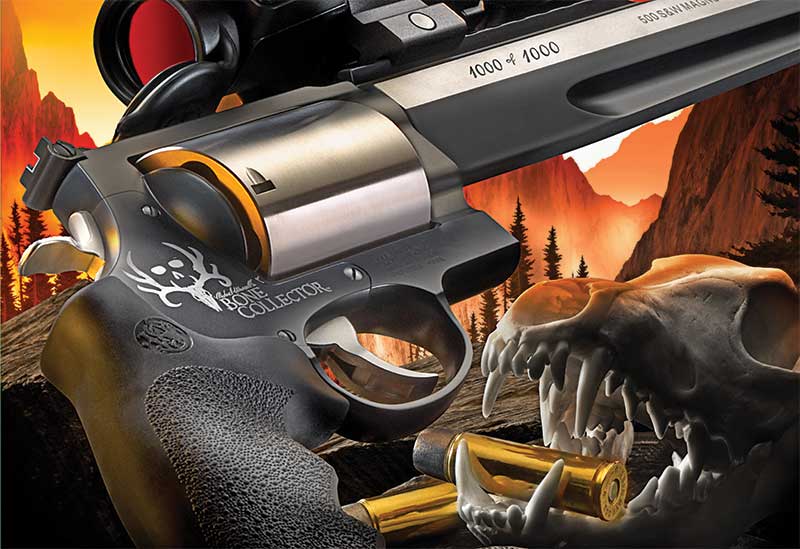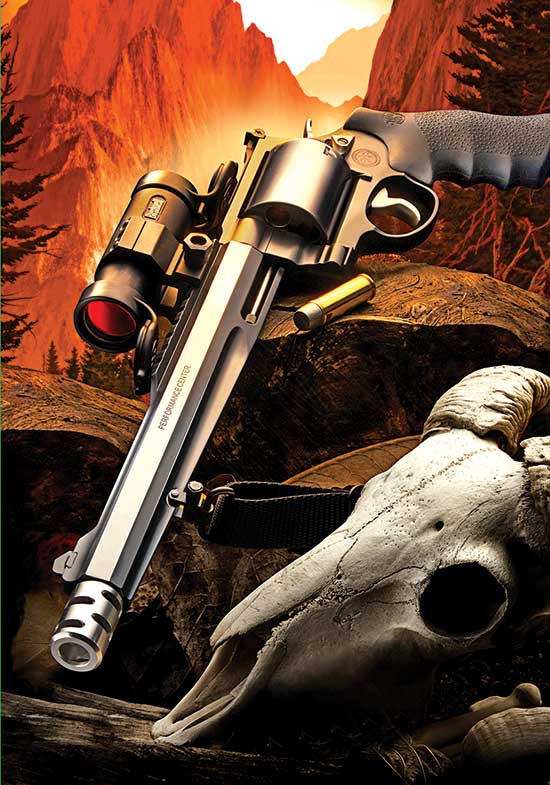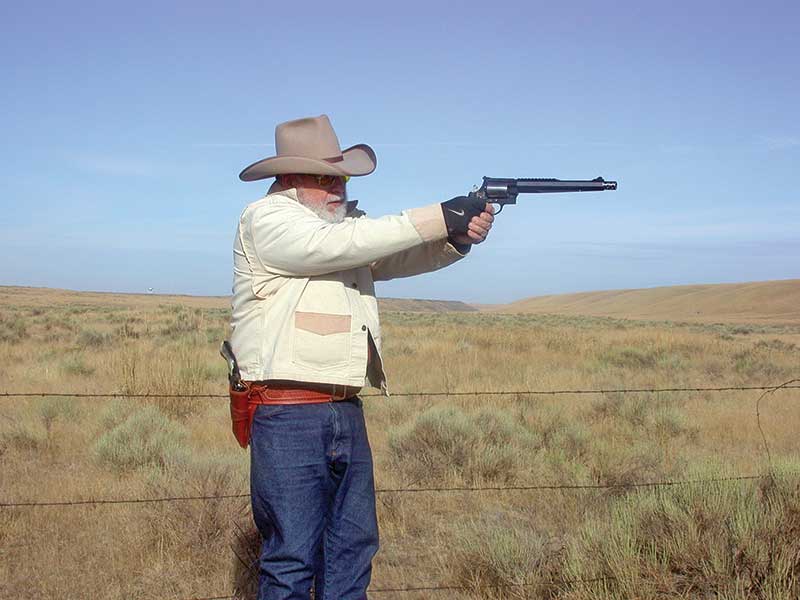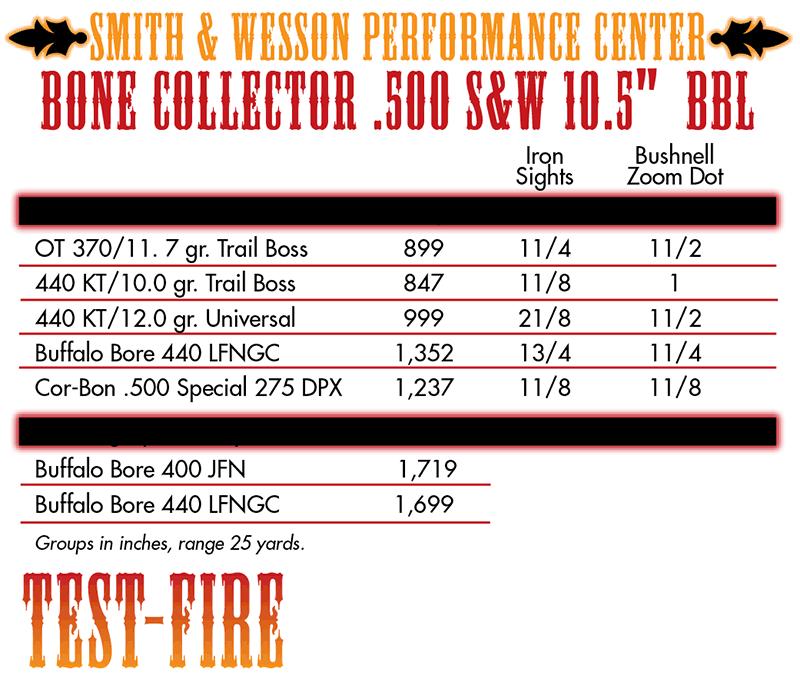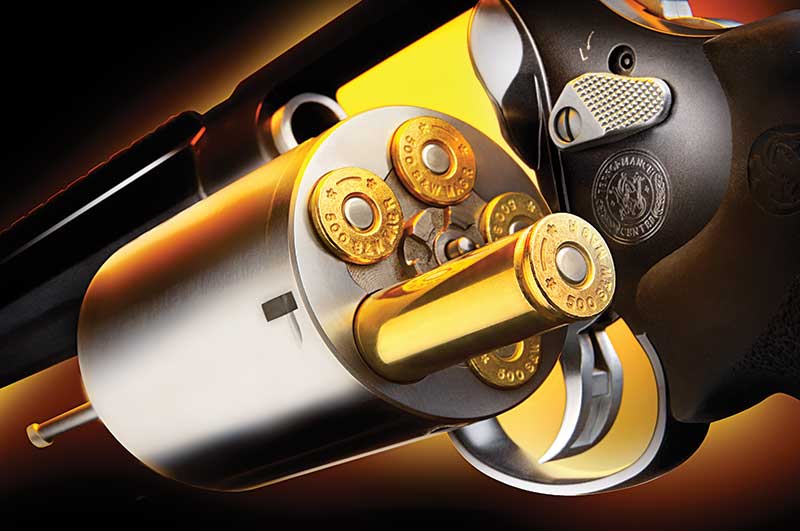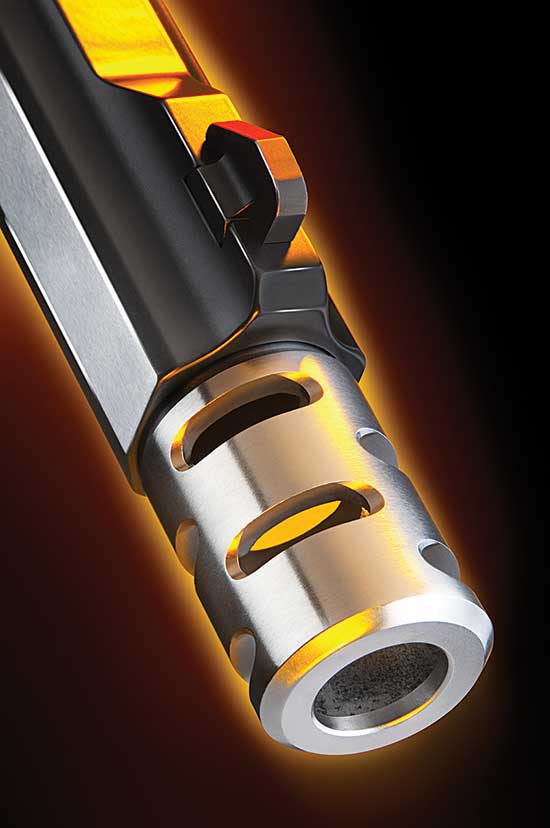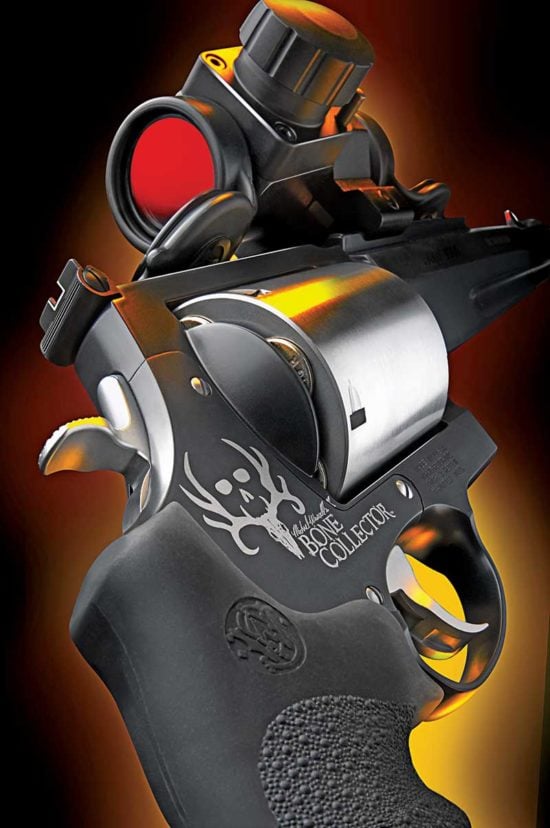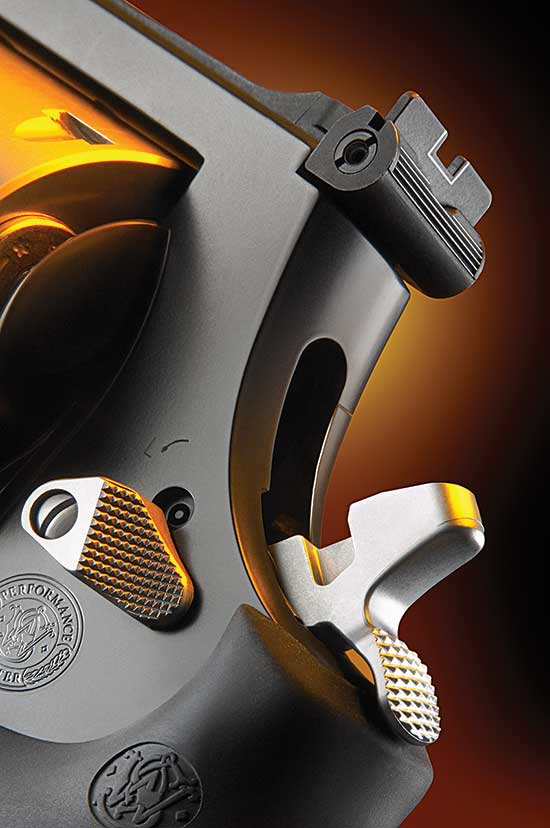S&W's Bone-Crushing Bone Collector
.500 S&W Magnum = .45-70!
For more than 60 years big-bore sixgunners had been perfectly content, at least most of them, to shoot the .45 Colt, .44 Russian, .44 WCF, .44 Special and the relative newcomer, the .45 Auto Rim. Then in 1935 Smith & Wesson raised the Big Bore Bar significantly with the introduction of the .357 Magnum. It’s most interesting to go back and read the reports when this magnificent revolver first came out and see the awe it inspired. To promote the new Magnum sixgun Col. Doug Wesson hunted with it, taking antelope, elk, moose and even grizzly bear.
Not too many sixgunners would choose the .357 Magnum today for such duties. The advertising called it more powerful than any .44 or .45, and in fact it was nearly double the muzzle velocity of any of the bigger bores of the era. Reloaders were cautioned to approach it with extreme care. We had reached the epitome of sixgun power, or so it was believed.
Twenty years later Smith & Wesson teamed up with Remington to give their new .44 Magnum the same muzzle velocity as the .357 Magnum and now we had really reached the top. However, even before the introduction of the .44 Magnum custom sixgunsmiths were experimenting with other cartridges using cut down rifle brass and/or 5-shot cylinders in hand built revolvers.
One such gent was a young gunsmith in Utah by the name of Dick Casull, whose .454 Magnum eventually received production status as the .454 Casull from Freedom Arms. This time the Big Bore Bar had been definitely raised to the utmost — but not so fast. Even as the .454 was being introduced to serious sixgunners John Linebaugh of Cody Wyoming was working on his .500 Linebaugh and then following up with the .475 Linebaugh.
What Top?
By this time sixgunners had learned to not rush to say we had reached the top. Even John Linebaugh went further stretching his .500 and .475 cartridges to 1.600″ and chambering them in custom 5-shot revolvers built on the Ruger Maximum frame. We had advanced from awe to just plain awful. Shooting those cartridges in a Perfect Packin’ Pistol-sized sixgun weighing less than four pounds was an experience long remembered. Several gunsmiths chambered the Linebaugh Longs in custom revolvers, however I think most, if not all, of them ceased producing these sixguns as they simply do not want to test-fire them.
There is absolutely nothing to compare to them when it comes to recoil. Dan Wesson had produced revolvers in the .445 SuperMag, however this cartridge in the four pound DW didn’t even come close to producing the brutal recoil of the .475 and .500 Linebaugh Longs.
The .500
In the early years of the 21st century, S&W, which had introduced sixgunners to the .357 Magnum in 1935, the .44 Magnum in 1956 and the .41 Magnum in 1964, now took a huge step for mankind with the introduction of the .500 S&W Magnum. John Linebaugh’s 1.600″ .500LL used .512″ bullets; Smith & Wesson .500 Magnum brass has a trim length of 1.615″ and uses .500″ bullets so the two can definitely not be interchanged. The S&W version is also loaded much heavier as it is used in larger, heavier revolvers, but both are five-shooters.
The first Smith & Wesson Model 500 I received for testing had an 83/8″ barrel with a muzzle brake. This was followed by a 4″ Packin’ Pistol version. During the past decade S&W has introduced other versions, and the latest, the test gun at hand, is from the Performance Center and known as the Bone Collector. It’s named after Michael Waddell’s popular Bone Collector hunting show seen on the Outdoor Channel, and is marked with the Bone Collector logo on the frame.
Smith & Wesson says of the Bone Collector: “Equipped with a variety of special features only the individual attention of master gunsmiths can achieve, the Model S&W500 Bone Collector is hand-cut and fit to ensure top-notch accuracy and precision. Additional Performance Center features include a heavy-duty ball detent lock-up between the cylinder crane and frame along with a chrome-flashed hammer and trigger. The trigger on the Model S&W500 Bone Collector also features an over-travel stop and the revolver is standard with a Performance Center action job. All these features contribute to a revolver capable of answering the needs of any serious handgun hunter.”
We could basically say here the .500 S&W Bone Collector is capable of handling any need in any situation. Power-wise, It’s basically a heavy-loaded .45-70 levergun load — in a revolver!
Hard Facts
Specs include a 5-shot cylinder, 10.5″ barrel, 360-degree muzzle brake, dovetailed red ramp front sight matched up with a white outline rear sight, rail mounted on top of the barrel shroud for use of a scope, 2-toned finish with stainless steel frame and cylinder, and soft synthetic finger groove grips. Overall length is 18″ with a weight of 82 ounces, or just over five pounds. That may be too heavy or too light depending upon your perspective. Whatever your perspective may be the Bone Collector is definitely too large and heavy for holstering so it’s provided with studs attached to holes under the barrel and in the grip frame for using a sling.
Shooters of my immediate acquaintance have a standard rule of thumb, which says the trigger pull should not be less than the weight of the revolver; with that in mind the 6-pound, single-action pull of the Bone Collector is right in line. This particular version is limited to a run of 1,000 pieces and the test gun is special in that it is marked “1000 of 1000.” The MSRP is $1,597.
Until the arrival of the .500, S&W’s largest revolver was the N-Frame .44 Magnum. The .500 was built on a completely new design with a much larger frame and cylinder and is designated the X-Frame. In spite of its great size and weight the Bone Collector actually balances quite well and in spite of all the aesthetic differences when compared to the traditional classic lines of the Smith & Wesson .44 Magnum, is also quite attractive in its own right.
To my eye the 2-toned finish is quite appealing, with the polished stainless steel cylinder and slab sides of the barrel matched up with the black matte finish of the rest of this “fivegun.” Also the top rail for scope mounting is not added on but actually machined as part of the barrel shroud. It’s definitely a revolver that shooters will be anxious to share with others, although it may be hard to find those among the faint of heart who actually want to shoot it.
Easy Starting
I’ve had extensive experience shooting the original Model 500 with both factory loads and handloads. In fact there are only two of us I know of who have published articles with large amounts of data. The reason is the .500 is not to be approached lightly and shooting it extensively takes a lot of energy and careful attention. It’s definitely manageable in the hunting field, however shooting off the bench, especially with hundreds of rounds, takes its toll very quickly. When it first came out nearly 10 years ago I was able to shoot all the loads available. However, shooting so many big guns of every kind for so many decades has definitely taken its toll. I am not faint of heart but I am definitely faint of hand and wrist.
For testing of this latest .500 Magnum from Smith & Wesson I approached it from the bottom up. That is, I loaded up easy-shooting loads, call them every day working loads, even fun loads, using Trail Boss powder. This is probably the simplest powder for anyone to use as standard procedure using straight walled cases is simply to load to the base of the bullet without compression. These days about 95 percent of my shooting of really big bore sixguns, .475 and up, is accomplished using Trail Boss.
Muzzle velocities, even with the 101/2″ barrel Bone Collector are only 850 to 900 fps using 370- and 440-grain bullets. That is just slightly more than half of the muzzle velocity accorded by the full-house .500 S&W loads from Buffalo Bore. However, they should not be taken lightly, as a 370- or 440-grain bullet at muzzle velocities normally associated with 230-grain .45 ACP hardball are definitely not in the mouse load category. They will certainly handle deer and deer-sized game usefully. For a slightly more powerful loading I go with the 440 Keith-style bullet over 12.0 grains of Universal for right at 1,000 fps.
In addition to these handloads I also used the Cor-Bon .500 Special loading using a 275-grain DPX (Deep Penetrating Expanding) bullet at 1,235 fps from the Bone Collector. This is basically a .44 Magnum level load and I was quite surprised at how well it shoots with its much shorter case in the long cylinder of the .500 Magnum. Whether using iron sights or with the Bushnell Zoom Dot in place, my 4- shot groups at 25 yards ran just barely over 1″.
Big Loads
The Bushnell Zoom Dot is a heavy-duty red dot sight which clamps to the rail on the top of the Bone Collector using one large mounting screw, which is tightened with a small crescent wrench. Both elevation and windage are accomplished by using a special wrench supplied with the unit and it was quite easy to adjust. The Zoom Knob allows the shooter the choice of everything from 1-MOA to 10-MOA red dots. It also comes with attached covers to protect the lenses when not in use.
Okay, the fun was over; it was time to get serious as I reached for the Buffalo Bore loads. The “light load” for the .500 from Buffalo Bore is a 440 LFNGC (Lead Flat Nose Gas Check) hard cast bullet which clocks out at 1,350 fps. Once I shot these I realized discretion is the better part of valor and while the spirit was willing the flesh was weak. The .357 Magnum was still too young for kindergarten when my hands attached to the rest of me arrived on this planet, so as much as it pains me to say it (no pun intended), my hands and wrists are beyond going beyond this level. I need whatever I’ve got left in my hands to keep shooting other loads and other sixguns. My apologies to both Smith & Wesson and Buffalo Bore for not being able to handle everything both the sixgun and load are capable of accomplishing.
I did chronograph Buffalo Bore’s two other loads, but just wasn’t up to accuracy testing. As expected Buffalo Bore’s loads chronographed out as advertised with the 400 JFN going over 1,700 fps and, the same bullet used in the “light load” was just under 1,700 fps. Again, these are extremely serious loads.
The Bone Collector is for Bone Crushin’ large, mean critters and I’m afraid extensive use by yours truly would revert the bone crushing to me. I do not consciously feel recoil when hunting, however long testing sessions are a different situation. The Bone Collector is easily termed an “Ultimate” big-bore revolver. There is, frankly, nothing walking on our earth you couldn’t hunt with it. And for just plain fun, well, if you’re up to it, so is The Bone Collector!
For more info: Smith & Wesson (800) 331-0852, www.smith-wesson.com
Subscribe To American Handgunner

Get More Revolver Content Every Week!
Sign up for the Wheelgun Wednesday newsletter here:

